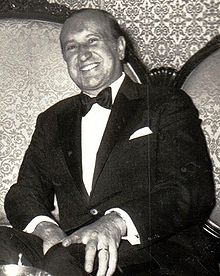- Misael Pastrana Borrero
-
Misael Pastrana Borrero 31st President of Colombia In office
7 August 1970 – 7 August 1974Preceded by Carlos Lleras Restrepo Succeeded by Alfonso López Michelsen 16th Colombia Ambassador to United States In office
17 January 1969 – 3 February1970President Carlos Lleras Restrepo Preceded by Hernan Echavarría Olózaga Succeeded by Douglas Botero Boshel Colombian Minister of Government In office
7 August 1966 – 6 November 1968President Carlos Lleras Restrepo Preceded by Pedro Gómez Valderrama Succeeded by Carlos Augusto Noriega Colombian Minister of Finance and Public Credit In office
1 September 1961 – 16 November 1961President Alberto Lleras Camargo Preceded by Hernando Agudelo Villa Succeeded by Jorge Mejía Palacio Colombian Minister of Public Works In office
9 November 1960 – 1 September1961President Alberto Lleras Camargo Preceded by Virgilio Barco Vargas Succeeded by Carlos Obando Velasco 12th Colombian Minister of Foment In office
5 May 1960 – 9 November 1960President Alberto Lleras Camargo Preceded by Rodrigo Llorente Martínez Succeeded by Rafael Unda Ferrero Personal details Born Misael Eduardo Pastrana Borrero
November 14, 1923
Neiva, Huila, ColombiaDied August 21, 1997 (aged 73)
Bogotá, DC, ColombiaNationality Colombian Political party Conservative Spouse(s) Maria Cristina Arango Vega Children Juan Carlos Pastrana Arango
Andrés Pastrana Arango
Jaime Pastrana Arango
Cristina Pastrana ArangoAlma mater Pontifical Xavierian University Profession Lawyer, Economist Religion Roman Catholic This name uses Spanish naming customs; the first or paternal family name is Pastrana and the second or maternal family name is Borrero.Misael Pastrana Borrero (November 14, 1923 – August 21, 1997), was a Conservative Party politician and President of Colombia from 1970 to 1974, the last presidential period of the National Front. Misael Pastrana became President after a close election campaign against Gen. Gustavo Rojas Pinilla, a former dictator. Mr. Pastrana's term is generally known for protecting the rights of large landowners and encouraging housing construction as an engine of growth. A law passed in 1973 barred the Government from expropriating land without the owner's consent. His administration also gave financial incentives to commercial agriculture, which created jobs and greatly improved farm wages.
Contents
Biographic data
Pastrana was born in Neiva, Huila.[1] He died in Bogotá, on August 21, 1997.
Personal life
Pastrana was a conservative politician Colombia, President of Colombia in the period 1970-1974. Born in the home of Misael Pastrana Pastrana and Elisa Borrero Perdomo, studied Laws in Javeriana University of Bogotá and in the Ferri Institute of Rome. He had been affiliated to the Conservative Party (which he would later rename as the Social Conservative Party). He was the private secretary of the President Mariano Ospina Pérez (1949-1952)and three times a minister during the second liberal presidency of Alberto Lleras Camargo (1958-1962).
During the Presidency of Carlos Lleras Restrepo, he was Minister of Government 1966-1968 and later ambassador in Washington from 1968-1970 President of the Worldwide Prize of Environment of the United Nations recognition given by having done in the planet, first Environmental Code for Natural Resources, Vice-president of Worldwide Prize for Peace of UNESCO. Founder of World-Wide Center of Computer Science next to Jean-Jacqes Serban-Shereiver in the seventies before the personal computer existed. Founder member of Interaction, group of former presidents and Chiefs of State of the United Nations to deal with great subjects the world and to present recommendations to the governments.
Presidency
During his four years in office, Pastrana was cautiously progressive. He sought to increase employment opportunities with a famous four-point strategy. He attempted to boost national savings as a way of moving away from dependency on foreign investment and credit, and he extended pensions rights for many people.
At the same time, he was a champion of "a car for every Colombian family", and was instrumental in bringing the French car-makers Renault to Colombia. He also promoted the first national environmental legislation in Latin America.
The end of his four year-term in office came in 1974, which also saw the end of the National Front governments. Pastrana then took on the mantle of the "natural leader" of the Conservative party. He proved unable to hold the different factions of the party together, however, and in consequence there has only been one Conservative president since his own term in office.
He died in Bogotá at the age of 73.[2] Married to Maria Cristina Arango, with whom he had three sons and one daughter. His second son, Andrés Pastrana Arango eventually became president of Colombia 1998 to 2002.
References
Categories:- 1923 births
- 1997 deaths
- People from Huila Department
- Pontifical Xavierian University alumni
- Colombian lawyers
- Colombian economists
- Presidents of Colombia
- Ambassadors of Colombia to the United States
- Colombian Conservative Party politicians
- Colombian Ministers of Finance and Public Credit
- Colombian Ministers of Foment
- Colombian Ministers of Government
Wikimedia Foundation. 2010.

